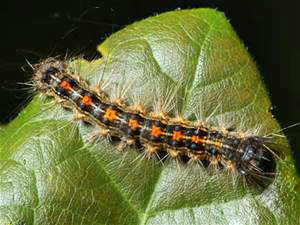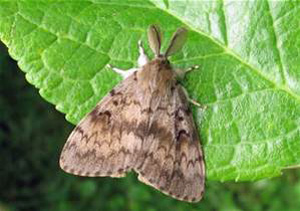Penn. DCNR to Begin Spraying Forests to Combat Gypsy Moth
![]() Print this Article | Send to Colleague
Print this Article | Send to Colleague
 The Pennsylvania, USA, State Bureau of Forestry staff are preparing for an aerial spraying effort to combat gypsy moth populations poised for spring outbreaks in the eastern and central portions of Pennsylvania, Department of Conservation and Natural Resources officials, reported this week.
The Pennsylvania, USA, State Bureau of Forestry staff are preparing for an aerial spraying effort to combat gypsy moth populations poised for spring outbreaks in the eastern and central portions of Pennsylvania, Department of Conservation and Natural Resources officials, reported this week. "This spraying effort goes far beyond trying to control an annoying and destructive insect -- it is needed to ensure the health of our valuable hardwoods when threatened with heavy defoliation," said DCNR Secretary Cindy Adams Dunn. "Amid drought, fire, or other stress factors, oaks often fall victim to the gypsy moth across the state."
The secretary noted that "heavy infestations" occurred in northeastern counties last spring and DCNR's forest health staff says that populations will be high in both the northeastern and central counties this spring.
"Last year, warm dry weather in April and May helped delay emergence of a fungus—a natural and most effective enemy of the gypsy moth—until June, and the result was nearly 700,000 acres of defoliation," Dunn said.
The secretary noted that despite recent cold snaps, weather in late winter and early spring has been warmer than usual, and gypsy moth eggs began hatching in some areas as early as April 17.
"The gypsy moth suppression program is conducted on a request basis, with a goal of preventing defoliation so that trees do not become stressed and succumb to disease and other pests," Dunn said.
A 136,000-acre suppression program in 352 treatment blocks is proposed for 2016 in 21 counties. They are: Berks, Carbon, Columbia, Cumberland, Dauphin, Huntingdon, Juniata, Lackawanna, Lebanon, Lehigh, Luzerne, Mifflin, Monroe, Northampton, Northumberland, Perry, Pike, Schuylkill, Snyder, Union, and Wyoming.
Aerial spraying by four helicopters and four fixed-wing airplanes principally will be on state-managed parks, forests, game lands, and federal lands (Raystown Lake), as well as residential lands in eight participating counties. Maps of the treatment areas are posted on the DCNR Bureau of Forestry website.
Though weather dependent, spraying is expected to begin late this week or in early May, and be completed by the end of May or early June.
Surveys of egg masses and other indicators across the state indicate gypsy moth populations are increasing and have the potential to cause major defoliation this spring, especially in eastern and central Pennsylvania.
In 2015, gypsy moth populations increased in eastern Pennsylvania after several years of high populations in the northwestern part of the state. DCNR treated 26,433 acres in 38 spray blocks in May in six northeastern counties.
Bureau of Forestry experts note the state's oak stands are especially vulnerable to gypsy moth infestation, often resulting in tree mortality. The loss of habitat, timber, and tree growth are considerable when gypsy moth populations are allowed to go untreated.
Gypsy moth defoliation in 2014 totaled 214,972 acres, and another 115,104 acres were defoliated by the fall cankerworm, a native forest insect defoliator. Aerial and ground surveys indicated a total of 431,956 acres of damage by forest pests in 2014.
In 2015, gypsy moth defoliation increased to 691,852 acres, with another 229,114 acres damaged by other spring defoliators, including the oak leaf roller. Surveys indicated a total of 1,029,894 acres of damage by forest pests in 2015.
Biological in nature, the applied insecticide must be ingested by young caterpillars as they feed on emerging foliage.
"Private woodland owners and public lands visitors must remember spraying is a suppression effort and a forest management effort to protect trees from moderate to severe defoliation," said Dr. Donald Eggen, the bureau's forest health manager. "The gypsy moth will continue its cyclic population with ups and downs about every five to ten years. We cannot eradicate the insect in Pennsylvania, only try to minimize the damage in areas where the land manager requests assistance. It's too well-established and is here to stay."
 Forestry bureau experts identify the gypsy moth as one of the most destructive forest pests in Pennsylvania. Feeding while in the larval—or caterpillar—stage, the insect usually hatches and begins feeding from mid- to late April in southern Pennsylvania, and in early to mid-May in the northern part of the state.
Forestry bureau experts identify the gypsy moth as one of the most destructive forest pests in Pennsylvania. Feeding while in the larval—or caterpillar—stage, the insect usually hatches and begins feeding from mid- to late April in southern Pennsylvania, and in early to mid-May in the northern part of the state.Oak, apple, sweet gum, basswood, birch, aspen, and willow trees are affected the most by the gypsy moth. Older larvae also will feed on hemlock, pines, spruces, northern white cedar, and other conifers. A tree begins to significantly suffer when 30% or more of its leaf surface is lost.
Begun in 1972, the forest insect spray program is a cooperative effort among DCNR's Bureau of Forestry, county governments, and the U.S. Department of Agriculture Forest Service's Forest Health Protection Unit.
The gypsy moth was introduced to North America in 1869 at Medford, Mass., where it was used in a failed silk-production experiment. The gypsy moth first reached Pennsylvania in Luzerne County in 1932, and since then has infested every county.


